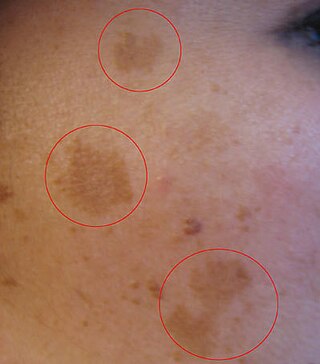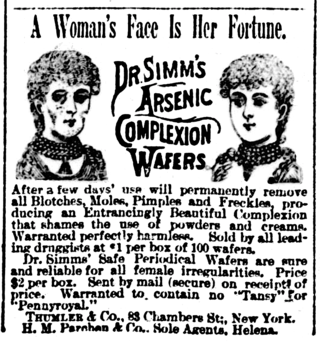| Hyperpigmentation | |
|---|---|
 | |
| Specialty | Dermatology |
| Causes | Melanogenesis |
The article's lead section may need to be rewritten.(February 2024) |
Hyperpigmentation is the darkening of an area of skin or nails caused by increased melanin.
| Hyperpigmentation | |
|---|---|
 | |
| Specialty | Dermatology |
| Causes | Melanogenesis |
The article's lead section may need to be rewritten.(February 2024) |
Hyperpigmentation is the darkening of an area of skin or nails caused by increased melanin.
Hyperpigmentation can be caused by sun damage, inflammation, or other skin injuries, including those related to acne vulgaris. [1] [2] [3] : 854 People with darker skin tones are more prone to hyperpigmentation, especially with excess sun exposure. [4]
Many forms of hyperpigmentation are caused by an excess production of melanin. [4] Hyperpigmentation can be diffuse or focal, affecting such areas as the face and the back of the hands. Melanin is produced by melanocytes at the lower layer of the epidermis. Melanin is a class of pigment responsible for producing color in the body in places such as the eyes, skin, and hair. The process of melanin synthesis (melanogenesis) starts with the oxidation of l-tyrosine to l-dopa by the enzyme tyrosine hydroxylase, then to l-dopaquinone and dopachrome, which forms melanin. [5]
As the body ages, melanocyte distribution becomes less diffuse and its regulation less controlled by the body. UV light stimulates melanocyte activity, and where concentration of the cells is greater, hyperpigmentation occurs. Another form of hyperpigmentation is post-inflammatory hyperpigmentation. These are dark and discoloured spots that appear on the skin following acne that has healed. [6]
Hyperpigmentation is associated with a number of diseases or conditions, including the following:
Hyperpigmentation can sometimes be induced by dermatological laser procedures.
There are a wide range of depigmenting treatments used for hyperpigmentation conditions, and responses to most are variable. [11]
Most often treatment of hyperpigmentation caused by melanin overproduction (such as melasma, acne scarring, liver spots) includes the use of topical depigmenting agents, which vary in their efficacy and safety, as well as in prescription rules. [12]
Many topical treatments disrupt the synthesis of melanin by inhibiting the enzyme tyrosine hydroxylase. [5]
Several are prescription only in the US, especially in high doses, such as hydroquinone, azelaic acid, [13] and kojic acid. [14] Some are available without prescription, such as niacinamide, [15] [16] l-ascorbic acid,[ citation needed ] retinoids such as tretinoin, [17] or cysteamine hydrochloride. [18] [19] Hydroquinone was the most commonly prescribed hyperpigmentation treatment before the long-term safety concerns were raised, [20] and the use of it became more regulated in several countries and discouraged in general by WHO. [21] For the US, only 2% is at present sold over-the-counter, and 4% needs prescription. In the EU hydroquinone was banned from cosmetic applications. [22]
Oral medication with procyanidin plus vitamins A, C, and E also shows promise as safe and effective for epidermal melasma. In an 8-week randomized, double-blind, placebo-controlled trial in 56 Filipino women, treatment was associated with significant improvements in the left and right malar regions, and was safe and well tolerated. [23] Other treatments that do not involve topical agents are also available, including fraction lasers [24] and dermabrasion. [12]
Laser toning using YAG lasers [25] and intense pulsed light have been used to treat hyperpigmentation such as melasma and post-inflammatory hyperpigmentation. [26]

Acne, also known as acne vulgaris, is a long-term skin condition that occurs when dead skin cells and oil from the skin clog hair follicles. Typical features of the condition include blackheads or whiteheads, pimples, oily skin, and possible scarring. It primarily affects skin with a relatively high number of oil glands, including the face, upper part of the chest, and back. The resulting appearance can lead to lack of confidence, anxiety, reduced self-esteem, and, in extreme cases, depression or thoughts of suicide.

Tretinoin, also known as all-trans retinoic acid (ATRA), is a medication used for the treatment of acne and acute promyelocytic leukemia. For acne, it is applied to the skin as a cream, gel or ointment. For leukemia, it is taken by mouth for up to three months. Topical tretinoin is also the most extensively investigated retinoid therapy for photoaging.

Adapalene is a third-generation topical retinoid primarily used in the treatment of mild-moderate acne, and is also used off-label to treat keratosis pilaris as well as other skin conditions. Studies have found adapalene is as effective as other retinoids, while causing less irritation. It also has several advantages over other retinoids. The adapalene molecule is more stable compared to tretinoin and tazarotene, which leads to less concern for photodegradation. It is also chemically more stable compared to the other two retinoids, allowing it to be used in combination with benzoyl peroxide. Due to its effects on keratinocyte proliferation and differentiation, adapalene is superior to tretinoin for the treatment of comedonal acne and is often used as a first-line agent. The Swiss company Galderma sells adapalene under the brand name Differin.

Periorbital dark circles are dark blemishes around the eyes. There are many causes of this symptom, including heredity and bruising.

Melasma is a tan or dark skin discoloration. Melasma is thought to be caused by sun exposure, genetic predisposition, hormone changes, and skin irritation. Although it can affect anyone, it is particularly common in women, especially pregnant women and those who are taking oral or patch contraceptives or hormone replacement therapy medications.

Hydroquinone, also known as benzene-1,4-diol or quinol, is an aromatic organic compound that is a type of phenol, a derivative of benzene, having the chemical formula C6H4(OH)2. It has two hydroxyl groups bonded to a benzene ring in a para position. It is a white granular solid. Substituted derivatives of this parent compound are also referred to as hydroquinones. The name "hydroquinone" was coined by Friedrich Wöhler in 1843.

Ochronosis is a syndrome caused by the accumulation of homogentisic acid in connective tissues. The condition was named after the yellowish (ocher-like) discoloration of the tissue seen on microscopic examination. Macroscopically, though, the affected tissues appear bluish-grey because of a light-scattering phenomenon known as the Tyndall effect. The condition is most often associated with alkaptonuria, but can occur from exogenous administration of phenol complexes such as hydroquinone. It was first described by Rudolf Virchow in 1865.

Azelaic acid (AzA) is an organic compound with the formula HOOC(CH2)7COOH. This saturated dicarboxylic acid exists as a white powder. It is found in wheat, rye, and barley. It is a precursor to diverse industrial products including polymers and plasticizers, as well as being a component of a number of hair and skin conditioners. AzA inhibits tyrosinase.

A lentigo is a small pigmented spot on the skin with a clearly defined edge, surrounded by normal-appearing skin. It is a harmless (benign) hyperplasia of melanocytes which is linear in its spread. This means the hyperplasia of melanocytes is restricted to the cell layer directly above the basement membrane of the epidermis where melanocytes normally reside. This is in contrast to the "nests" of multi-layer melanocytes found in moles. Because of this characteristic feature, the adjective "lentiginous" is used to describe other skin lesions that similarly proliferate linearly within the basal cell layer.

Cysteamine is an organosulfur compound with the formula HSCH2CH2NH2. A white, water-soluble solid, it contains both an amine and a thiol functional groups. It is often used as salts of the ammonium derivative [HSCH2CH2NH3]+ including the hydrochloride, phosphocysteamine, and the bitartrate.The intermediate pantetheine is broken down into cysteamine and pantothenic acid.

Liver spots are blemishes on the skin associated with aging and exposure to ultraviolet radiation from the sun. They range in color from light brown to red or black and are located in areas most often exposed to the sun, particularly the hands, face, shoulders, arms and forehead, and the scalp if bald.

Skin whitening, also known as skin lightening and skin bleaching, is the practice of using chemical substances in an attempt to lighten the skin or provide an even skin color by reducing the melanin concentration in the skin. Several chemicals have been shown to be effective in skin whitening, while some have proven to be toxic or have questionable safety profiles. This includes mercury compounds which may cause neurological problems and kidney problems.

beta-Arbutin, also known as β-arbutin or by its International Nomenclature of Cosmetic Ingredients (INCI) name, arbutin, is a glycosylated derivative of hydroquinone. β-Arbutin is naturally present in the leaves and bark of a variety of plants, notably the bearberry plant, Arctostaphylos uva-ursi. Utilized as a biosynthetic active ingredient in topical treatments for skin lightening, β-arbutin is aimed at addressing hyperpigmentation issues. Its mechanism of action involves inhibiting the activity of tyrosinase, an essential enzyme for melanin synthesis in the human skin, thereby leading to a reduction in hyperpigmentation. It is important to distinguish β-arbutin from its structurally similar stereoisomer, α-arbutin, which exhibits similar effects in clinical applications.
Pigmentation disorders are disturbances of human skin color. There may be a loss or reduction, which may be related to loss of melanocytes or the inability of melanocytes to produce melanin or transport melanosomes correctly.
Melanonychia is a black or brown pigmentation of a nail, and may be present as a normal finding on many digits in Afro-Caribbeans, as a result of trauma, systemic disease, or medications, or as a postinflammatory event from such localized events as lichen planus or fixed drug eruption.

Photoaging or photoageing is a term used for the characteristic changes to skin induced by chronic UVA and UVB exposure. Tretinoin is the best studied retinoid in the treatment of photoaging.
Postinflammatory hypopigmentation is a cutaneous condition characterized by decreased pigment in the skin following inflammation of the skin.

Glyceryl octyl ascorbic acid (GO-VC) is an amphipathic derivative of vitamin C consisting of two ether linkages: a 1-octyl at position 2 and a glycerin at position 3. The chemical name is 2-glyceryl-3-octyl ascorbic acid. The isomer in which these two groups are swapped is also known.
Postinflammatory hyperpigmentation (PIH) is a skin condition characterized by the darkening of the skin (hyperpigmentation) following an inflammatory injury, such as acne, dermatitis, infectious disease, or trauma. Less frequently, it may occur as a complication of a medical procedure performed on the skin. It is a common cause of skin discoloration and can affect individuals of all skin types.

alpha-Arbutin, or α-arbutin, is a glycosylated hydroquinone, and an anomer of the naturally occurring arbutin. α-Arbutin is used in the cosmetic and pharmaceutical industries for its skin lightening effects, treatment of hyperpigmentation, and as a safer alternative to hydroquinone.